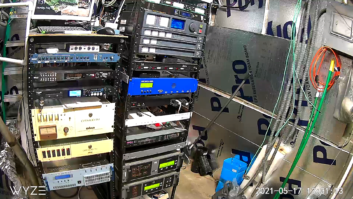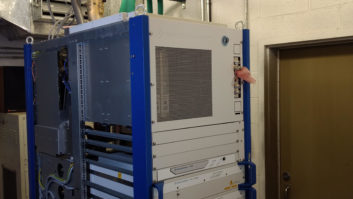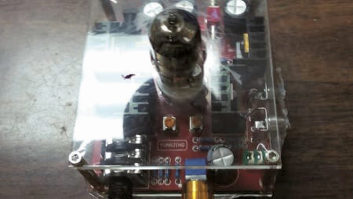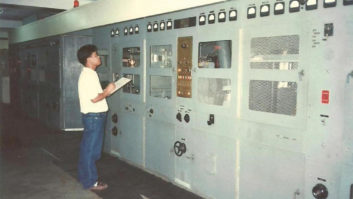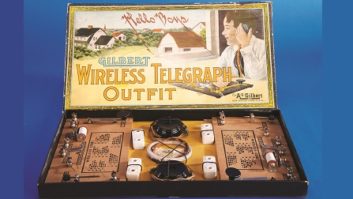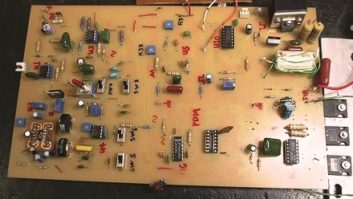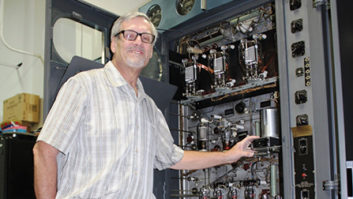
Fig. 1: The Eimac 4CX300A tube, used in a number of transmitters made in the 1970s and ’80s, has been discontinued. (Image courtesy Roy J. Tellason)
Time marches on. The most recent casualty it has tromped under its boots is the Eimac 4CX300A tube, used as a driver in a number of transmitters made in the 1970s and ’80s.
I confirmed with Eimac that manufacture of this tube has been discontinued and that it cannot be rebuilt economically; the rebuild would cost more than the tube is worth.
There is a chance Eimac will build a “lifetime buy” quantity for the federal government and that some may be available for U.S. broadcast purposes; but that decision rests on the government’s requirements and cannot be confirmed at this time.
As quantities of the tube on the surplus market are sold, you can expect the cost of remaining stock to increase. Other manufacturers are another solution, but with them go the risks of a tube that is not up to the Eimac standard. What kind of luck have you had?
Among common uses for this tube are Harris 10 kW FM transmitters manufactured from about 1964 until the HT series was introduced in the early ’80s, including FM10G, FM10H, FM10H2, FM10H3 and FM10K. The tube was also used as a driver in certain models of the older Sparta transmitters.
Even though these transmitters may no longer be supported by the factory, many are still on the air or used as backups. So what can you do?
I’ve talked to a few contract engineers who were investigating the wholesale replacement of this driver stage with a solid-state “brick” or low-power exciter/PA equivalent.
The drawback is that the inter-stage coupling between the driver plate to the final tube grid is not 50 ohms. There is also a DC blocking voltage issue.
Jerry Mathis handles engineering for Clear Channel/Urban Radio Broadcasting in Tupelo and Meridian, Miss. Among his stations, he maintains an FM10K. He’s used the surplus tubes but in most cases gets only six months out of them; it becomes an expensive proposition.
He recommends not trying to substitute a more common tube, such as the 4CX250B, in the circuit. The plate voltage for the IPA is from the center tap of the HV supply. This puts the plate at about half of the PA plate voltage, which for the 4CX10,000 is about 6600 volts. Three thousand volts is too high for the 4CX250B plate and can cause flashovers under the right circumstances.
Jerry adds that the 4CX300Y will not work in the circuit, either. In this case, the tube capacitances are radically different from the A version.
* * *
Engineer Ira Wilner writes in response to Buc Fitch’s home-brew RPU antenna project: “You get what you pay for.”
Ira raises several concerns. First and foremost, threaded rod stock is not flexible. If accidently bowed it most likely will shear through the threads and break in half. There is a reason commercial whips are made of spring steel and cost more.
From an electronic standpoint, Ira reminds readers that matching a new antenna to an RPU transmitter, without stressing the radio in the process, can be tricky. Some transmitters display a variable output impedance, rarely is it exactly 50 ohms. At resonance, a 1/4-wave whip is around 38 ohms impedance, not 50. This could cause a transmitter to put out higher power than optimal, especially if its own source impedance is less than 50 ohms.
The best way to tune and match an antenna is to use a vector network analyzer (two-port) or its less expensive smaller brother, the vector impedance analyzer (single-port).
With a VIA you can tune for 50 ohms rather than for resonance. Or you can tune for resonance if the transmitter originally was set up to match into a non-50 ohm load. Either way you’ll have a better picture of what’s going on with your antenna.
Here is where you reach into your ham shack and pull out a device you can use commercially too. Ira owns an Array Solutions AIM 4170C. It is basically the front end of a single-port vector impedance analyzer, to which you add a host computer and Array Solutions’ software to create a high-quality instrument at a bargain price. See www.arraysolutions.com.

Fig. 2: Ask a sign shop for their scrap magnetic material before it’s thrown away … This isn’t cheap compared to a RadioShack SWR bridge, but you get precision that approaches laboratory-grade, and a ton of data displayed on nice color graphs, including a Smith chart if desired. Furthermore, the latest software includes a talking SWR meter so you can keep your eyes and hands on the antenna adjustments while the software talks you in.
Ira says that in a pinch he has used this to tune an AM broadcast antenna matching network. Array Solutions makes a much more costly professional model with a more powerful test signal and tighter front-end tracking filter to reduce broadcast band interference, especially for AM antenna work.
Ira’s points are well taken, though Buc had offered this “roll your own” RPU antenna as an inexpensive way of adding a spare or emergency antenna to your remote arsenal at a time when equipment budgets have shrunk.
* * *
Mark Voris is, like so many engineers, a resourceful guy.

Fig. 3: … and turn it into removable labels for metal racks and bookshelves. The SBE-certified chief engineer for the Spirit Catholic Radio Network in Omaha, Neb., came up with a no-cost labeling solution:
Take a couple of station T-shirts to a local sign shop and swap them for some scraps or trimmings from a magnetic sign. This is the material sign shops use to print magnetic-backed banner signs that you see on the sides of trucks or cars promoting their businesses.
Mark cuts these scraps to size, as seen in Fig. 2, and uses them as labels on metal shelves and racks.
Use a permanent marker or label maker to create a removable label that can be moved if needed. Mark says these no-cost labels are really handy when you need to label something temporarily in a steel equipment rack.
Got another idea for using this magnetic strip material? E-mail the suggestion with a high-resolution picture to [email protected].
John Bisset marked his 40th year in radio in broadcasting recently. Submissions for this column are encouraged and qualify for SBE recertification credit.






